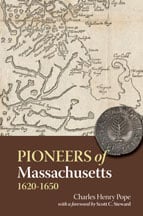 To be complete, the well-stocked genealogical library should include general works on our research interests. Biographical dictionaries and other compendia are useful for looking at our ancestors’ contemporaries and their activities; they often provide clues for specific queries when the record in any one case is lacking, sending us off to an overlooked source or locality where the trail seemed cold.
To be complete, the well-stocked genealogical library should include general works on our research interests. Biographical dictionaries and other compendia are useful for looking at our ancestors’ contemporaries and their activities; they often provide clues for specific queries when the record in any one case is lacking, sending us off to an overlooked source or locality where the trail seemed cold.
For the period of the seventeenth-century Great Migration, the contemporary standard is, of course, the books in Robert Charles Anderson’s Great Migration Study Project (published by NEHGS since 1995, and presently running to twelve volumes). Starting with The Great Migration Begins (covering the period 1620-33 and supplemented by The Pilgrim Migration and The Winthrop Fleet), and then The Great Migration, second series (for 1634 and 1635), Anderson has mined earlier published and unpublished compilations for lists of immigrants to New England, tirelessly cross-checking them against the surviving colony, county, town, church, probate, and deed record to create living portraits of seventeenth-century New Englanders.
One of his primary resources has been Charles Henry Pope’s The Pioneers of Massachusetts, first published in Boston in 1900 (with corrections 1902-4). Pope is full of implicit (and sometimes explicit) questions, the answers to which can send the researcher off in fresh directions:
John Parker, shoemaker of Boston: “Is he not the son of John and Jane?” (p. 344; the supposed parents are seen on p. 343)
John Abbot, “accidentally shot at Concord in 1636 by Matthew Bridge. . . Probably the person who came, [aged] 16, in the Hopewell in 1635, with Marie, [aged] 16” (p. 9)
“Nathaniel [Stone] had Nathaniel, Samuel and Elizabeth bapt. 29 (7) 1666. Was he a son of John?” (p. 437)
It is these questions, and a myriad of others, that Anderson – and other modern-day genealogists – has set out to answer, aided by the curiosity and skill of earlier compilers. Genealogists with an interest in seventeenth-century New England will want this volume as a resource: it might not, and was not intended to be, the last word on its subject, but it will help sort out Smith immigrants (pp. 418-24), two Henry Brights (p. 69), and three William Knights (p. 274). Anyone who has ever labored over which John Smith was which will find this portable reference work invaluable.
Adapted from the foreword to the new NEHGS edition of Charles Henry Pope's Pioneers of Massachusetts.
Share this:
About Scott C. Steward
Scott C. Steward has been NEHGS’ Editor-in-Chief since 2013. He is the author, co-author, or editor of genealogies of the Ayer, Le Roy, Lowell, Saltonstall, Thorndike, and Winthrop families. His articles have appeared in The New England Historical and Genealogical Register, NEXUS, New England Ancestors, American Ancestors, and The Pennsylvania Genealogical Magazine, and he has written book reviews for the Register, The New York Genealogical and Biographical Record, and the National Genealogical Society Quarterly.View all posts by Scott C. Steward →